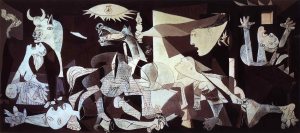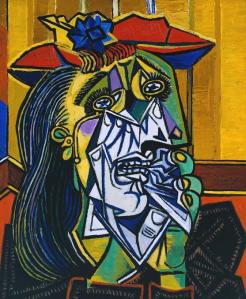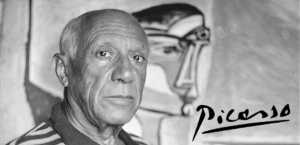Biography 1:
Pablo Picasso was born in Málaga, Spain. When he was baptized, he was named after various saints and relatives: Pablo Diego José Francisco de Paula Juan Nepomuceno María de los Remedios Cipriano de la Santísima Trinidad Martyr Patricio Clito Ruíz y Picasso. His father, Jose Ruiz Blasco, was an artist and art professor who gave Pablo art lessons. His mother was Maria Picasso y Lopez. According to his mother, his first word was “piz” when he was trying to say “lápiz,” the Spanish word for pencil.
Picasso was not a good student. He often had to go to detention. Here’s what he said about it.
“For being a bad student I was banished to the ‘calaboose’ – a bare cell with whitewashed walls and a bench to sit on. I liked it there, because I took along a sketch pad and drew incessantly … I could have stayed there forever drawing without stopping ”
When he was nine, Picasso finished his first painting, Le picador. It shows a man on a horse at a bullfight. When he started painting, he used a realistic style. He began to experiment with different techniques and styles. When he was 13, he was admitted to the School of Fine Arts in Barcelona, Spain. When he was 16, Picasso’s father and uncle decided to send him to Madrid’s Royal Academy of San Fernando. This was Spain’s top art school. He did not like formal instruction and soon stopped going to classes. He loved Madrid and enjoyed going to The Prado museum to see paintings by famous Spanish painters. He particularly like El Greco’s work.
In 1900, Picasso went to Paris. He met Max Jacob, a journalist and poet. Max helped Picasso learn to speak French. He also met many of the famous artists who lived in Paris. In 1905, American art collectors Leo and Gertrude Stein began to collect his work and helped to make him famous.
He and Georges Braque invented Cubism, a form of painting that featured simple geometric shapes. He is also known for making collages – gluing previously unrelated things together with images. He created oil paintings, sculpture, drawings, stage designs, tapestries, rugs, etchings, collage, and architecture. No other painter or sculptor was as famous while he was still alive. It is estimated that Picasso produced at least 50,000 works of art: 1,885 paintings; 1,228 sculptures; 2,880 ceramics, roughly 12,000 drawings, many thousands of prints, and numerous tapestries and rugs. He also wrote plays and poetry. He became very wealthy.
Some of his famous paintings include: The Old Guitarist; Asleep and Seated Woman, which portray Marie-Therese Walter, one of the women he loved; Guernica, a mural about the Spanish Civil War; and Three Musicians.
Picasso loved many women. He married two of them, Olga Khokhlova and Jacqueline Roque. He had four children: Paulo, Maya, Claude and Paloma, who is famous for her jewelry designs. He died April 8, 1973 in Mougins, France.
Picasso quotes:
“I paint objects as I think them, not as I see them. ”
“All children are artists. The problem is how to remain an artist once he grows up. ”
“He can who thinks he can, and he can’t who thinks he can’t. This is an inexorable, indisputable law. ”
“Action is the foundational key to all success.”
Biography 2:
- Occupation: Artist
- Born: October 25, 1881 in Málaga, Spain
- Died: April 8, 1973 in Mougins, France
- Famous works: The Pipes of Pan, Three Musicians, Guernica, The Weeping Woman
- Style/Period: Cubism, Modern Art
Biography 2:
Where did Pablo Picasso grow up?
Pablo Picasso grew up in Spain where he was born on October 25, 1881. His father was a painter and art teacher. Pablo liked to draw from an early age. Legend has it that his first word was «piz», short for «pencil» in Spanish. It soon became apparent that Pablo had little interest in school, but was an extremely talented artist.
When he was fourteen Pablo attended a famous art school in Barcelona. A few years later he went to another school in Madrid. However, Pablo was bored with the classic teachings of art school. He didn’t want to paint like people hundreds of years ago. He wanted to create something new.
Blue Period (1901-1904)
In 1901, Pablo’s close friend Carlos Casagemas committed suicide. Pablo became very sad. Around the same time he began painting in Paris. For the next four years his paintings were dominated by the color blue. Many of the subjects were sad and somber looking. He painted people with elongated features and faces. Some of his paintings from this period include Poor People on the Seashore and The Old Guitarist.
Rose Period (1904 – 1906)
Eventually Pablo got over his depression. He also fell in love with a French model. He began to use warmer colors in his paintings including pinks, reds, oranges, and beiges. Art historians call this time in Pablo’s life the Rose Period. He also began to paint happier scenes such as circuses. Some of his paintings from this period include The Peasants and Mother and Child.
Cubism (1907 – 1921)
In 1907 Picasso began to experiment with a new style of painting. He worked with another artist named Georges Braque. By 1909 they had created a completely new style of painting called Cubism. In Cubism the subjects are analyzed and broken up into different sections. Then the sections are put back together and painted from different perspectives and angles. Go here to see an example of Picasso’s Cubism art.
In 1912 Picasso began to combine Cubism and collage. This was where he would use sand or plaster in his paint to give it texture. He would also apply materials such as colored paper, newspapers, and wallpaper to his paintings to give them added dimension.
Some of Picasso’s Cubism paintings include Three Musicians and the Portrait of Ambroise Vollard.
Neoclassical Style
Although Picasso would continue to experiment with Cubism, around 1921 he went through a period of painting more classical style paintings. He borrowed ideas from Renaissance painters such as Raphael. He created powerful characters that almost appeared to be three-dimensional, like statues. Some of his works in this style include The Pipes of Pan and Woman in White.
Surrealism
Around 1924 Pablo became interested in the Surrealist movement. Surrealist paintings weren’t supposed to make any sense. They often appear like something you would see in a dream or a nightmare. Although Picasso didn’t become a member of the movement, he did incorporate some of their ideas into his paintings. Some people called this time his Monster period. Examples of the surrealism influence on Picasso’s art include Guernica and The Red Armchair.
Legacy
Today, Pablo Picasso is considered the greatest artist of the 20th century. Many people consider him to be one of the greatest in all of art history. He painted in a number of different styles and created many unique contributions to the world of art. Near the end of his life he painted a number of self portraits. One of his last works of art was a self portrait done with crayon on paper entitledSelf-Portrait Facing Death. He died a year later at the age of 91 on April 8, 1973.
Interesting Facts about Pablo Picasso
- His full name is Pablo Diego José Francisco de Paula Juan Nepomuceno María de los Remedios Cipriano de la Santísima Trinidad Ruiz y Picasso. Wow!
- His mother once told him when he was a child that «If you become a soldier, you’ll be a general. If you become a monk you’ll end up as the pope.»
- In the 1930s Picasso became fascinated with the mythical creature the Minotaur. This creature had the body of a man and the head of a bull. It appeared in many of his pieces of art.
- He produced over 1,800 paintings and 1,200 sculptures.
- Many of his paintings have been sold for over $100 million!
- He was married twice and had four children.


